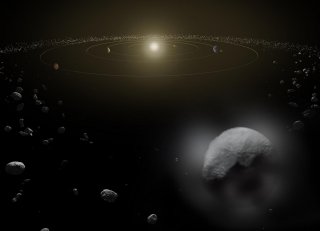‘Alien’ Asteroids Make Our Solar System Their Home
In the last couple of years, interstellar visitors ‘Oumuamua and 2I/Borisov created great excitement in the stargazing community. But according to a new study published in the Monthly Notices of the Royal Astronomical Society, there is now a cluster of interstellar asteroids within our solar system hiding in plain sight.
In the last couple of years, interstellar visitors ‘Oumuamua and 2I/Borisov created great excitement in the stargazing community. But according to a new study published in the Monthly Notices of the Royal Astronomical Society, there is now a cluster of interstellar asteroids within our solar system hiding in plain sight.
These asteroids, however, did not recently make their way our solar system. In fact, they have been here for billions of years, likely when Earth itself was forming some 4.5 billion years ago.
The study noted that these asteroids probably originated in a different star system. But the vast distances between star systems we see today were likely smaller billions of years ago, as other infant systems were nearby when our solar system was coming into being.
“The close proximity of the stars meant that they felt each others’ gravity much more strongly in those early days than they do today,” Fathi Namouni, a researcher at the Observatoire de la Cote d'Azur and lead study author, said in a statement. “This enabled asteroids to be pulled from one star system to another.”
Namouni and fellow researcher Maria Helena Moreira Morais, of the Universidade Estadual Paulista in Brazil, delved into numerical modeling to simulate the early years of our solar system and to zero in on the whereabouts of the asteroids billions of years ago.
The computer simulations positioned the asteroids traveling in a perpendicular orbit to the plane where our solar system’s planets and asteroids orbit the sun. Moreover, the asteroids were very distant from the original disk where the planets initially formed. As other planets were forming in our solar system, such data suggested that the asteroids were captured from a different star system.
These 19 asteroids are now orbiting the sun, along with other asteroids called centaurs, which are located between the planets Jupiter and Neptune. Centaurs are considered to be highly unusual because they are like both asteroids and comets. Two-thirds of centaurs likely came from the fringes of the solar system, according to NASA.
“The discovery of a whole population of asteroids of interstellar origin is an important step in understanding the physical and chemical similarities and differences between solar system-born and interstellar asteroids,” Morais said in a statement.
“This population will give us clues about the sun’s early birth cluster, how interstellar asteroid capture occurred and the role that interstellar matter had in chemically enriching the solar system and shaping its evolution.”
Ethen Kim Lieser is a Tech Editor who has held posts at Google, The Korea Herald, Lincoln Journal Star, AsianWeek and Arirang TV. He currently resides in Minneapolis.
Image: Reuters.

